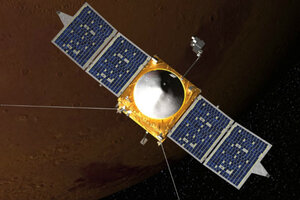On Mars: It's Curiosity's moment to shine, but MAVEN is in the works
In 2014, Curiosity and MAVEN are slated to team up to help scientists unravel the mystery behind Mars' vanishing atmosphere: How did a wet, warm planet lose that thin layer that can preserve the building blocks of life?

Artist's conception of MAVEN Mars orbiter.
NASA/GSFC
When NASA's latest Mars rover Curiosity survived its "seven minutes of terror" plunge through the planet's atmosphere in early August and phoned home to say all was well, the mission's scientists and engineers were ecstatic. They had put themselves in a good position to see if their target, Gale Crater and its three-mile-high central summit, might at one time have hosted an environment suitable for life.
But the atmosphere through which Curiosity descended also plays a key role in determining the planet's hospitality. Engineers and technicians are now assembling MAVEN, an orbiter slated for launch in November 2013 that will unravel the mystery of Mars' vanishing atmosphere.
Combined with key measurements Curiosity will take at the surface, MAVEN's measurements at the top of Mars' atmosphere are expected to allow researchers to reconstruct a history of the atmosphere – including the rate at which the planet has lost water over its 4.6-billion-year history.
Water is a key ingredient for the emergence of organic life. One of the questions Curiosity will help answer: Did water ever collect in Gale Crater? MAVEN is asking: Where did any surface water ultimately go?
Moreover, a thick atmosphere is one line of defense against cosmic rays, as well as extreme forms of ultraviolet radiation and energetic particles, which stream from the sun as "solar wind" and flood Mars' immediate surroundings during powerful solar storms. These forms of radiation can make for a bad day at the office for organisms on a planet's surface or for the complex organic molecules on the surface that could give rise to simple forms of life.
Scientists have been interested in making MAVEN-like measurements at the red planet since the 1980s, says Bruce Jakosky, the mission's lead scientist.
Scientists had long known that Mars' atmosphere was thin – about 1 percent as dense as Earth's atmosphere. But it took the Pioneer-Venus orbiter in 1978 to show that researchers could record the processes eroding another planet's atmosphere as they happened.
Researchers realized these were important measurements to make at Mars as well, says Dr. Jakosky, a researcher working at the interface of planetary geology and astrobiology at the University of Colorado at Boulder.
"Without going and measuring what's actually happening, you can't have any hope of understanding" the unique mix of factors that turned Mars from what many scientists hold as a wet, warm planet early in its history to the dry, radiation-bathed surface the planet presents today.
Eight sensors on the orbiter will allow scientists to tackle the atmosphere's history in three broad ways.
Orbiters currently at Mars have shown that atoms are being stripped from the atmosphere today – swept off as the solar wind, solar storms, and their magnetic fields flow past the planet. During its year-long primary mission, MAVEN will collect data on space weather's influence on Mars' upper atmosphere.
MAVEN also will measure extreme-ultraviolet radiation reaching Mars from the sun. This radiation breaks up molecules in the upper atmosphere, liberating lighter atoms, especially hydrogen, which then can easily be swept into interplanetary space.
Finally, MAVEN will measure the ratios of different forms, or isotopes, of five elements in the upper atmosphere – hydrogen, nitrogen, carbon, oxygen, and argon.
Typically planetary atmospheres are awash with normal hydrogen, the lightest atom, compared with its rarer, heavier sibling, deuterium. On Mars, however, the relative abundance of deuterium in the atmosphere is much higher than anywhere else in the solar system.
"That means that a lot of hydrogen has escaped," Jakosky says, since the heavier deuterium is less likely to leave the planet.
"By understanding something about the escape processes, and by measuring those ratios today, and measuring the ratios as they escape, we can get something that allows us to directly extrapolate back to learn how much of that atom was lost over time," he says.
Curiosity will be a crucial teammate for several kinds of measurements.
For instance, one of the rover's main instruments – known as SAM – will provide high-precision measurements of the atmosphere's composition at the surface, in addition to its analysis of soil and rock samples. Indeed, Jakosky is on the team that will analyze and interpret SAM data. SAM's information on the atmosphere at ground level, combined with similar, top-of-the-atmosphere measurements from MAVEN, will directly gauge the amounts and types of elements that Mars' atmosphere loses over time.
Once MAVEN ends its science mission, it will serve as a communications relay between spacecraft on the Martian surface and Earth. The US and European orbiters at Mars are getting a bit long in the tooth.
So far, the project, approved in 2008, is proceeding a bit ahead of schedule and on budget, notes David Mitchell, MAVEN project manager at NASA's Goddard Space Flight Center in Greenbelt, Md. If it makes its 20-day launch window next year, Maven would arrive in 2014.
"We're all so excited to see Curiosity on the ground there safely," he says. "I'm not a scientist, but I'm really excited to see what happens with the synergism" between Curiosity, MAVEN, the still-roving Mars veteran Opportunity, and other missions, he says.

